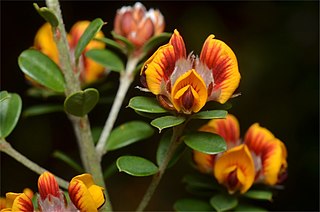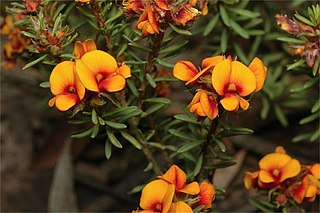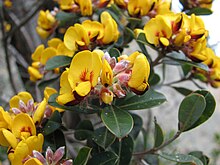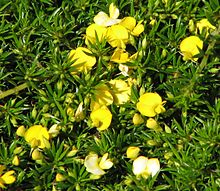
Daviesia, commonly known as bitter-peas, is a genus of about 130 species of flowering plants in the family Fabaceae, and is endemic to Australia. Plants in the genus Daviesia are shrubs or small trees with leaves modified as phyllodes or reduced to scales. The flowers are arranged singly or in groups, usually in leaf axils, the sepals joined at the base with five teeth, the petals usually yellowish with reddish markings and the fruit a pod.

Podolobium, commonly known as shaggy peas, is a genus of six species of flowering plants in the family Fabaceae that are endemic to eastern Australia. The genus was formally described by botanist Robert Brown in Hortus Kewensis in 1811.

The Mirbelioids are an informal subdivision of the plant family Fabaceae that includes the former tribes Bossiaeeae and Mirbelieae. They are consistently recovered as a monophyletic clade in molecular phylogenies. The Mirbelioids arose 48.4 ± 1.3 million years ago. Members of this clade are mostly ericoid (sclerophyllous) shrubs with yellow and red flowers found in Australia, Tasmania, and Papua-New Guinea. The name of this clade is informal and is not assumed to have any particular taxonomic rank like the names authorized by the ICBN or the ICPN. Members of this clade exhibit unusual embryology compared to other legumes, either enlarged antipodal cells in the embryo sac or the production of multiple embryo sacs. There has been a shift from bee pollination to bird pollination several times in this clade. Mirbelioids produce quinolizidine alkaloids, but unlike most papilionoids, they do not produce isoflavones. Many of the Mirbelioids have pseudoraceme inflorescences.

Michael Douglas Crisp is an emeritus professor in the Research School of Biology at the Australian National University located in Canberra. In 1976, he gained a PhD from the University of Adelaide, studying long-term vegetation changes in arid zones of South Australia. In 2020, Crisp moved to Brisbane, where he has an honorary position at the University of Queensland. Together with colleagues, he revised various pea-flowered legume genera.
Carolyn F. Wilkins is an Australian botanist, who currently works for the Western Australian Department of Biodiversity, Conservation and Attractions.

Pultenaea borea is a species of flowering plant in the family Fabaceae and is endemic to Queensland, Australia. It is an erect shrub with elliptic to linear or egg-shaped leaves and yellow to orange and red flowers.
Pultenaea bracteamajor is a species of flowering plant in the family Fabaceae and is endemic to Queensland. It is an erect shrub with cylindrical leaves and yellow to orange and red flowers.
Pultenaea bracteaminor is a species of flowering plant in the family Fabaceae and is endemic to Queensland. It is an erect shrub with cylindrical leaves and yellow to orange and red flowers.
Pultenaea craigiana is a species of flowering plant in the family Fabaceae and is endemic to near Ravensthorpe in the south of Western Australia. It is an erect, spindly shrub with densely hairy young stems, egg-shaped leaves with the narrower end towards the base, and yellow and red flowers.
Pultenaea elusa, commonly known as elusive bush-pea, is a species of flowering plant in the family Fabaceae and is endemic to a small area of New South Wales. It is a low shrub with sharply-pointed linear leaves, and dense clusters of yellow to orange and red to purple flowers. It has not been seen since 1938.

Pultenaea parrisiae, commonly known as bantam bush-pea, or Parris's bush-pea, is a species of flowering plant in the family Fabaceae and is endemic to south eastern continental Australia. It is a low-lying sub-shrub with linear to lance-shaped leaves with the narrower end towards the base, and yellow to purple flowers with red markings.
Pultenaea robusta is a species of flowering plant in the family Fabaceae and is endemic to eastern Australia. It is an erect shrub with hairy branches, linear leaves, and yellow to orange and red to purple, pea-like flowers.
Pultenaea rodwayi is a species of flowering plant in the family Fabaceae and is endemic to south-eastern New South Wales. It is an erect shrub with hairy branchlets, linear leaves, and yellow to orange and red, pea-like flowers.

Pultenaea stricta, commonly known as rigid bush-pea, is a species of flowering plant in the family Fabaceae and is endemic to south-eastern continental Australia. It is a slender, erect or low-lying shrub with elliptic to egg-shaped leaves with the narrower end towards the base, and yellow and red, pea-like flowers.
Pultenaea strobilifera is a species of flowering plant in the family Fabaceae and is endemic to the south-west of Western Australia. It is an open to dense, domed or spindly, erect shrub with simple leaves and yellow-orange and salmon pink to bright pink flowers.

Pultenaea subalpina, commonly known as rosy bush-pea, is a species of flowering plant in the family Fabaceae and is endemic to a restricted area of Victoria. It is a rigid, prostrate to erect or spreading shrub with linear leaves and pink, pea-like flowers.

Pultenaea subspicata, commonly known as low bush-pea, is a species of flowering plant in the family Fabaceae and is endemic to south-eastern continental Australia. It is a low-lying, prostrate or mat-forming shrub with elliptic leaves and yellow to pink and orange-red, pea-like flowers.
Pultenaea vestita, commonly known as feather bush-pea, is a species of flowering plant in the family Fabaceae and is endemic to south-western continental Australia. It is an erect to prostrate, sometimes mat-forming shrub with elliptic to linear or lance-shaped leaves, and yellow and red, pea-like flowers.
Pultenaea indira is a species of flowering plant in the family Fabaceae and is endemic to the south-west of Western Australia. It is an erect or low-lying shrub with plate-like or fissured bark near the base, densely hairy stems above, linear to lance-shaped leaves with the narrower end towards the base, and yellow, red and maroon flowers.













